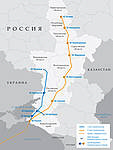|
Gazprom pushing ahead with gas pipeline projects
Feb. 11, 2014 + + + Alexey Miller, Chairman of the
Gazprom Management Committee held a meeting dedicated to the South Stream
and Southern Corridor projects. It was pointed out that the new route of
Russian gas supply meant to increase the reliability of supply to European
consumers and mitigate transit risks was being built in compliance with
the schedule.
Pre-construction activities at the South Stream offshore section are in
full swing. An agreement to supply pipes for the first string of the gas
pipeline was signed on January 29, 2014. On February 7 a contract was
concluded for the independent certification of South Stream's offshore
section to ensure conformity with DNV-OS-F101, one of the main
international standards. This standard specifies the requirements for
design, construction and operation of offshore gas pipelines with proper
consideration of security and environmental protection requirements.
It is planned to complete and promulgate the results of the bidding
procedure among deep-water pipe-laying companies as well as to sign a pipe
supply contract for the second offshore string of the gas pipeline before
the end of the first quarter of 2014. The construction of South Stream's
offshore section will start in autumn 2014.
Following Bulgaria and Serbia, Hungary will set to constructing the
onshore gas pipeline in the second quarter of 2015. At present, design and
survey operations are underway at the Hungarian section, spatial planning
and environmental impact assessment (EIA) documents are under development
for the Hungarian, Slovenian and Croatian sections.
With a view to
implement power projects in Republika Srpska, an intergovernmental
agreement with Bosnia and Herzegovina is being negotiated.
The meeting participants were also informed about the progress with the
Southern Corridor project – a Russian gas pipeline system intended, inter
alia, for feeding gas into South Stream.
The line pipe construction (Western Route, including the Kubanskaya CS –
Korenovskaya CS interconnector) is currently underway as part of the
project's first phase. By now, 477.5 out of 880.6 kilometers have been
welded and lowered in, which accounts for 54 per cent of the whole Western
Route. Hydraulic testing has been conducted at some constructed sections.
The necessary gas compressor capacities are under construction. In
particular, the core process equipment is being installed at the Russkaya
compressor station, which will be the global leader in terms of installed
capacity – 448 MW. Similar operations are underway at the Korenovskaya and
Kazachya compressor stations; the construction site is being prepared for
the Shakhtinskaya compressor station.
It was emphasized that all the state-of-the-art process, engineering and
construction solutions applied by Gazprom while implementing the South
Stream project took account of natural & climatic and geological
peculiarities of the region. At the same time, considerable efforts are
aimed at maintaining a high level of security and preserving the existing
ecosystems. Thus, one of the most complicated gas pipeline sections – the
Kuban River crossing – was constructed using directional drilling, thereby
leaving the riverbed undisturbed and having no influence on navigation and
fishing.
In addition, the Urengoy – Novopskov gas pipeline is being further
expanded at the Petrovsk – Pisarevka section in order to supply the
necessary gas volumes via the Western Route. A junction point, a
connection gas pipeline and interconnectors at the Pisarevka compressor
station have already been constructed, the reconstruction of three out of
six compressor stations, namely Yekaterinovka, Bubnovka and Pisarevka, has
started.
The meeting resulted in assigning tasks aimed at the timely execution of
the South Stream and Southern Corridor projects.
Background
The South Stream gas pipeline is Gazprom's global infrastructure project
aimed at constructing a gas pipeline with a capacity of 63 billion cubic
meters across the Black Sea to Southern and Central Europe for the purpose
of diversifying the natural gas export routes and eliminating transit
risks. The first gas will be supplied via South Stream in late 2015. The
gas pipeline will reach its full capacity in 2018.
South Stream's offshore section will run under the Black Sea from the
Russian coast to Bulgaria. The total length of the Black Sea section will
exceed 930 kilometers and its maximum depth will be more than two
kilometers.
A 1,455-kilometer onshore section will cross Bulgaria, Serbia, Hungary,
Slovenia and will end in Italy. Gas branches from the main pipeline route
will be built to Croatia and to Republika Srpska.
Gazprom Group is implementing the Southern Corridor GTS project in the aim
of supplying additional gas to a number of Russia's central and southern
regions in order to develop industrial and utility sectors, intensify
gasification and ensure gas supply into South Stream.
The project covers eight Russian constituent entities, including the
Nizhny Novgorod, Penza, Saratov, Volgograd and Voronezh Regions, the
Republic of Mordovia and the Krasnodar Territory.
The total length of the gas transmission system will be 2,506.2
kilometers. The project stipulates building 10 compressor stations with a
total capacity of 1,516 MW. The annual throughput of the Southern Corridor
gas pipeline system will be 63 billion cubic meters. The project is to be
delivered before late 2017.
Source: Gazprom / PennEnergy / Oil & Gas Journal /
Offshore Magazine
|


 Worldwide more than
Worldwide more than